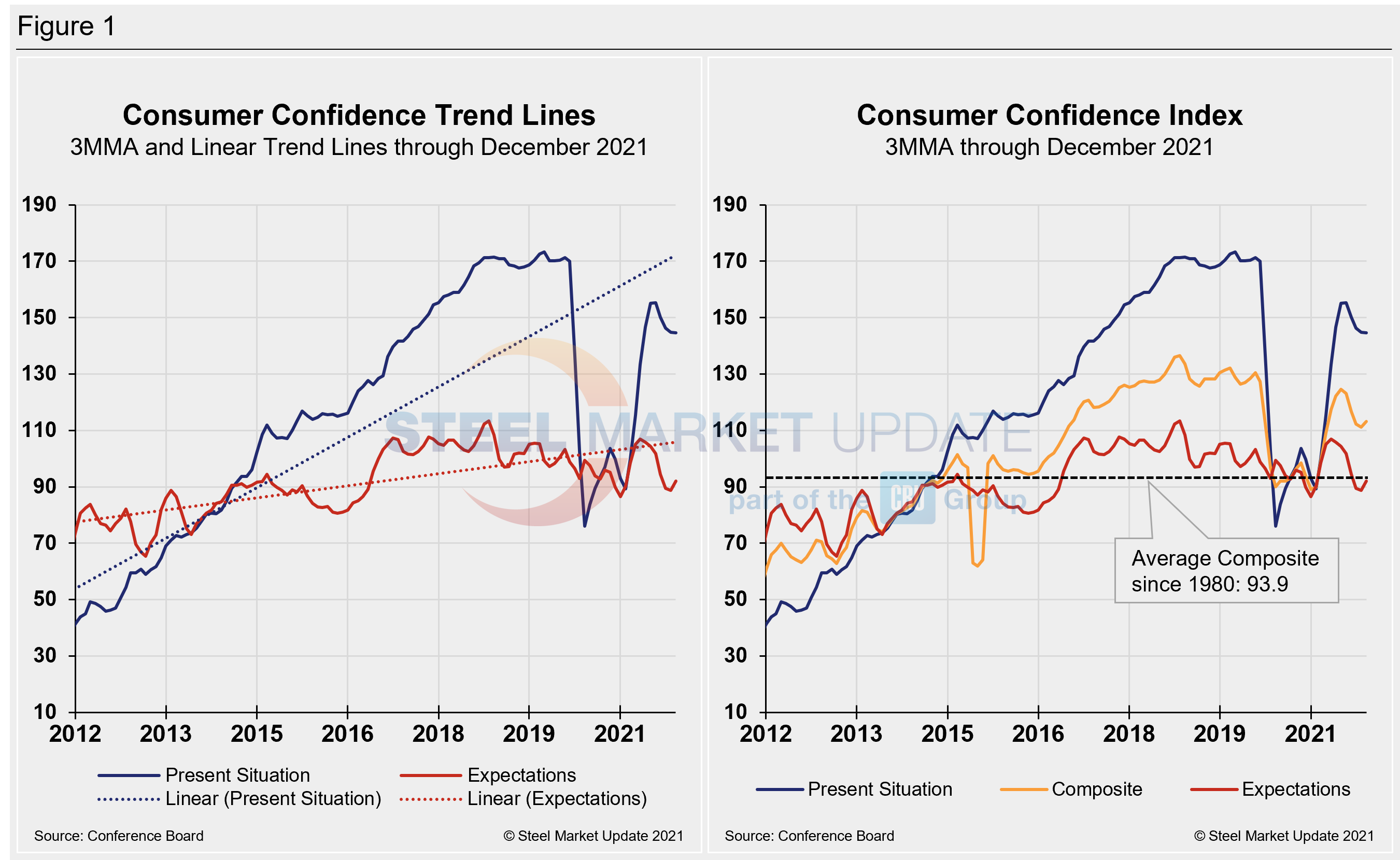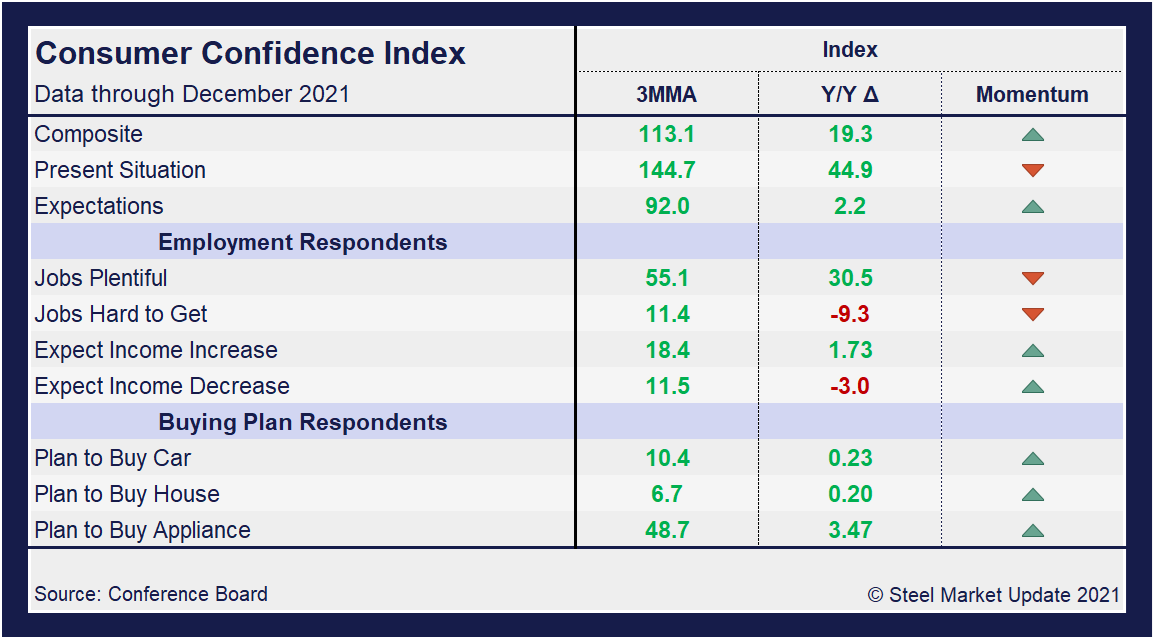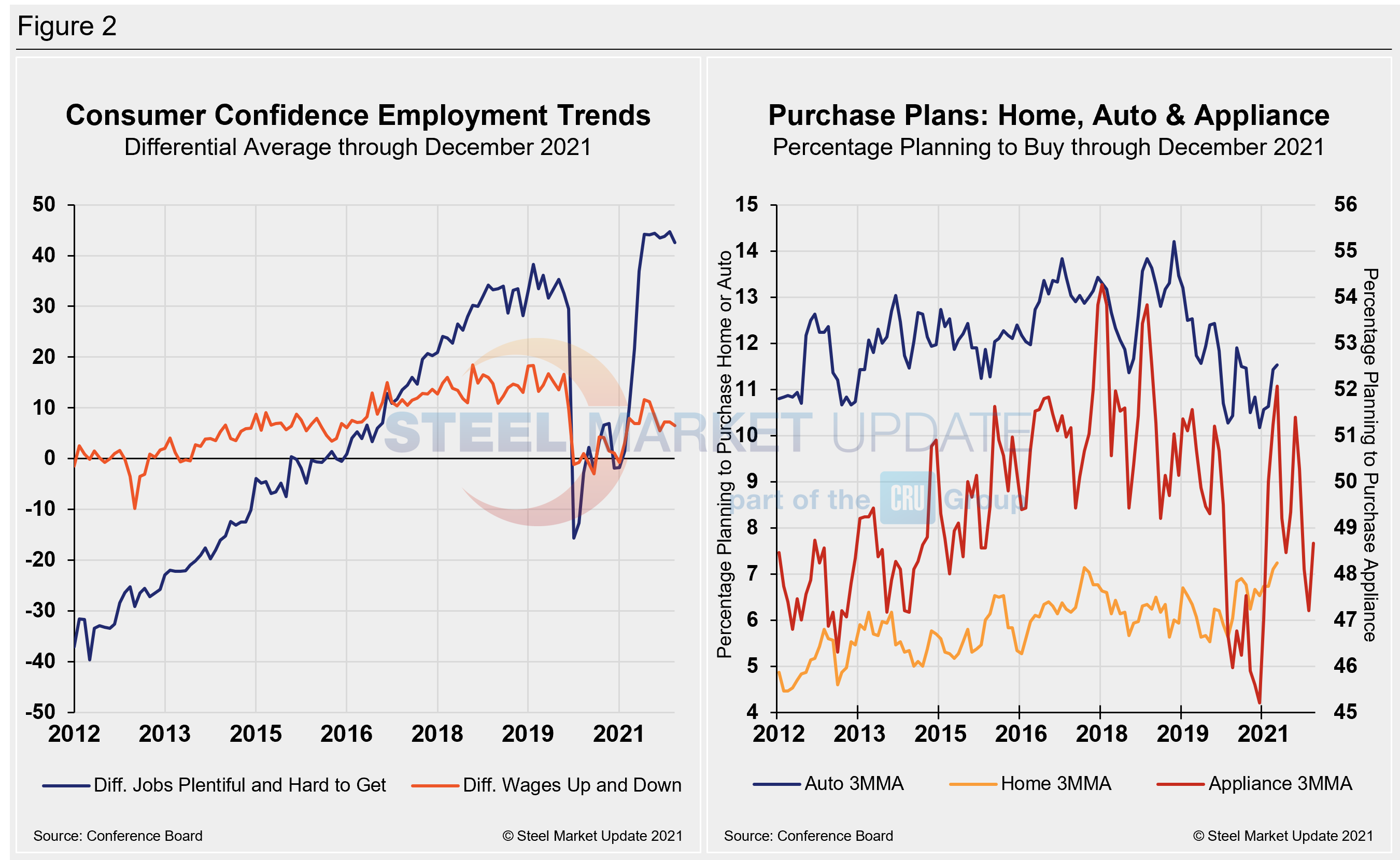Economy

Consumer Confidence Edges Up Again in December
Written by David Schollaert
December 22, 2021
Steel Market Update is pleased to share this Premium content with Executive members. For information on upgrading to a Premium-level subscription, email Info@SteelMarketUpdate.com.
U.S. consumer confidence rose for the third straight month in December, following a slight upward revision on November’s results and steady momentum after decreasing from July through September, reported The Conference Board.
Sentiment towards the economy was improved from initial expectations, as consumers’ concerns about inflation and COVID dipped. Despite the easing, the report notes both these factors will continue to present headwinds for consumer spending and overall confidence next year.
“Consumer confidence improved further in December, following a very modest gain in November,” said Lynn Franco, senior director of economic indicators at The Conference Board. “The Present Situation Index dipped slightly but remains very high, suggesting the economy has maintained its momentum in the final month of 2021. Expectations about short-term growth prospects improved, setting the stage for continued growth in early 2022. The proportion of consumers planning to purchase homes, automobiles, major appliances, and vacations over the next six months all increased.
“Meanwhile, concerns about inflation declined after hitting a 13-year high last month as did concerns about COVID-19, despite reports of continued price increases and the emergence of the Omicron variant,” Franco said. “Looking ahead to 2022, both confidence and consumer spending will continue to face headwinds from rising prices and an expected winter surge of the pandemic.”
The headline index grew by 3.9 points in December to 115.8 after edging up 0.3 points in November. The result was still 13.1 points behind its peak of 128.9 seen in June, but a positive move to close out the year, pushing 28.7 points above the low point seen in January, when the index measured just 87.1.
November’s present situation index, which is based on consumers’ assessment of current business and labor market conditions, fell for the second straight month, a 0.3-point decline month on month to a reading of 144.1. The expectations index, which is based on consumers’ short-term outlook for income, business and the labor market, expanded by 6.7 points to 96.9, the third straight month of growth.
Calculated as a three-month moving average (3MMA) to smooth out the volatility, The Conference Board’s composite index rose in December to 113.1 versus 111.1 in November – rising for the second time in three months but still well below the pre-pandemic high of 130.4 last February. Despite the recent inconsistencies, the index remains higher than the 93.8 seen a year ago. The composite index is made up of two sub-indexes: consumers’ view of the present situation and their expectations for the future. Figure 1 below notes the 3MMA linear trend lines from January 2012 through December 2021 versus the trend lines of all three subcomponents of the index: present situation, composite and future expectations. All three were above the average composite line in October 2020 before falling consecutively through February. The surge from March through June pulled all three indexes above the composite line once again, but all have since eroded, pulling expectations below the average composite line as it tries to recover.

On a 3MMA basis comparing December 2021 with December 2020 in the table below, the present situation has an index reading of 144.7, a fractional 0.1-point dip from the month prior but still 44.9 points above the year-ago reading. Expectations are at 92.0, up 3.4 points from November, and 2.2 points above year-ago levels. Although two out of the three indexes show positive gains against year-ago measures when the economy was still recovering from the first wave of COVID-19, the momentum indicator is still moving down. December’s growth, coupled with November’s upward revision was a welcome sign to a wavering consumer confidence, especially ahead of the New Year.
When comparing current 3MMA totals to the 2019 pre-pandemic year, the composite is still down 13.9 points, while the present situation is down 25.5 points. The expectations reading is down 6.2 points in December when compared to the same 2019 period. The consumer confidence report also includes both employment data and some purchase plans and these are likewise summarized in the table below. The color codes show improvement or deterioration of the individual components.
The composite, present situation and expectations indices had been trending up, recovering much of what was lost in the fallout from the global pandemic, but momentum shifted downward during the third quarter, driven by the surge in Delta variant cases. The fourth quarter has seen a bit of a rally, but the measures remain below the pre-summer highs.

People found jobs slightly less plentiful in December and were a bit less optimistic about wage increases compared to the month prior. The differential between those finding jobs plentiful and those having difficulty was 42.6 in December, down from 44.7 in November. The measure has easily eclipsed the most recent pre-pandemic high of 35.3 in January 2020, and despite some recent inconsistencies is a strong rally from the -1.8 seen at the beginning of the year. The differential between those expecting wages to rise versus those expecting wages to fall is presently 6.5, down 0.7 points month on month and down from the recent high of 11.6 in June.
Spending plans for consumer goods as measured by automobiles, homes and appliances had been trending up through June, but started slowing in July. Since then, figures have moved down in four out of the past six months, however, all three moved up in December. Automotive buying plans saw the strongest increase, up 2.9 points or 32.2% month on month in December to a reading of 11.9. Home buying rose 1.7 points to 7.5, matching its strongest pandemic-era reading last seen in February. Appliance buying rose in December, up 3.0 points to 50.8 in December. These recent dynamics and historical movements are illustrated below in Figure 2.

About The Conference Board: The Conference Board is a global, independent business membership and research association working in the public interest. The monthly Consumer Confidence Survey®, based on a probability-design random sample, is conducted for The Conference Board by Nielsen. The index is based on 1985 = 100. The composite value of consumer confidence combines the view of the present situation and of expectations for the next six months.
By David Schollaert, David@SteelMarketUpdate.com

David Schollaert
Read more from David SchollaertLatest in Economy

Steel groups welcome passage of budget bill
Steel trade groups praised the passage of the Big Beautiful Bill (BBB) in Congress on Thursday.

Industry groups praise Senate for passing tax and budget bill
The Steel Manufacturers Association and the American Iron and Steel Institute applauded the tax provisions included in the Senate's tax and budget reconciliation bill.

Chicago PMI dips 0.1 points in June
The Chicago Purchasing Managers Index (PMI) slipped 0.1 points to 40.4 points, in June.

Multi-family pullback drives housing starts to 5-year low in May
US housing starts tumbled in May to a five-year low, according to figures recently released by the US Census Bureau.

Architecture firms still struggling, ABI data shows
Architecture firms reported a modest improvement in billings through May, yet business conditions remained soft, according to the latest Architecture Billings Index (ABI) release from the American Institute of Architects (AIA) and Deltek.
